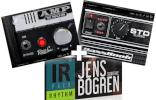Citation:
Sigma Martin Guitar Model #s - Here's What they Mean
“B” = Bass (or “Black” if used at the end of a model name as in TB-1B)
“C” = Concert
“CE” = Cutaway/Electric
“D” = Dreadnought shape
“E”= Electric
“G” = Grand (as in GC Grand Concert)
“H” = Herringbone purling around body edges and usually the sound hole.
“M” = Mahogany (usually the back and sides)
“N” = Natural finish
“R” = Rosewood fretboard
“S” = Solid back and sides
“SB” = Solid Body (electric guitar)
“ST” = Solid Top (usually Spruce)
“STB” = Solid top and bottom (probably Spruce, but maybe Spruce on top, Mahogany or Rosewood on bottom -- but solid wood, not laminate.
“T” = Translucent finish
“TB” = Thin Body as in TB-1B (Thin Body, Model#1, Black color.)
“12” = 12 strings
Codes designating color or finishing details (R, H, B, etc.) are usually the last letter in a model name.
Therefore, a Sigma SDR28H Acoustic Guitar, for example, has solid (as opposed to plywood) back and sides (S), a Dreadnought shape (SD), a Rosewood fretboard (SDR), model #28, which compares to the Martin style it copies, although I don’t have a comparison list (SDR2
, with Herringbone purling . . . so its an SDR28H.
Model numbers usually designate quality and price, within a model range. For example, a DM-3 is higher in price, and better in quality, finish and detail than a DM-2 . My CS-6, for example, is top-of-the-line, compared to its CS-3 cousin.
As for prices, the solid woods fetch more than the laminates (i.e. plywood); the higher model numbers (within a model range) usually have more details and features (like purling, enclosed tuners, etc.) and so fetch higher prices. But, in the end, condition is everything. A mint and ORIGINAL condition, low-end Sigma will fetch more than a beat-up high-end model with non-vintage tuners. An original hard-shell case also adds value.
Check eBay completed auctions for current selling prices. In the end, a thing is only worth what someone will pay for it.
There are always exceptions to the above list of model codes, because Sigma guitars were made in different countries over a number of decades. You might, for example, find that "S" means "Spruce" on some models and "M" might mean "Maple". So look carefully at an instrument and use your good judgment when interpreting the model names.
Find out why other Sigma guitar owners love their instruments by browsing the reviews (listed by model name) at this link:
http://reviews.harmony-central(...)Sigma
More info on a few older Sigma models here:
http://www.sigmaguitars.com/index.html
Hope this helps all you Sigma Acoustic guitar players and collectors out there.
http://www.acousticguitarforum(...)47425
Ce modèle précis ne semble pas très répandu. En cherchant sur les site japonais, on trouve plus d'infos un peu...
